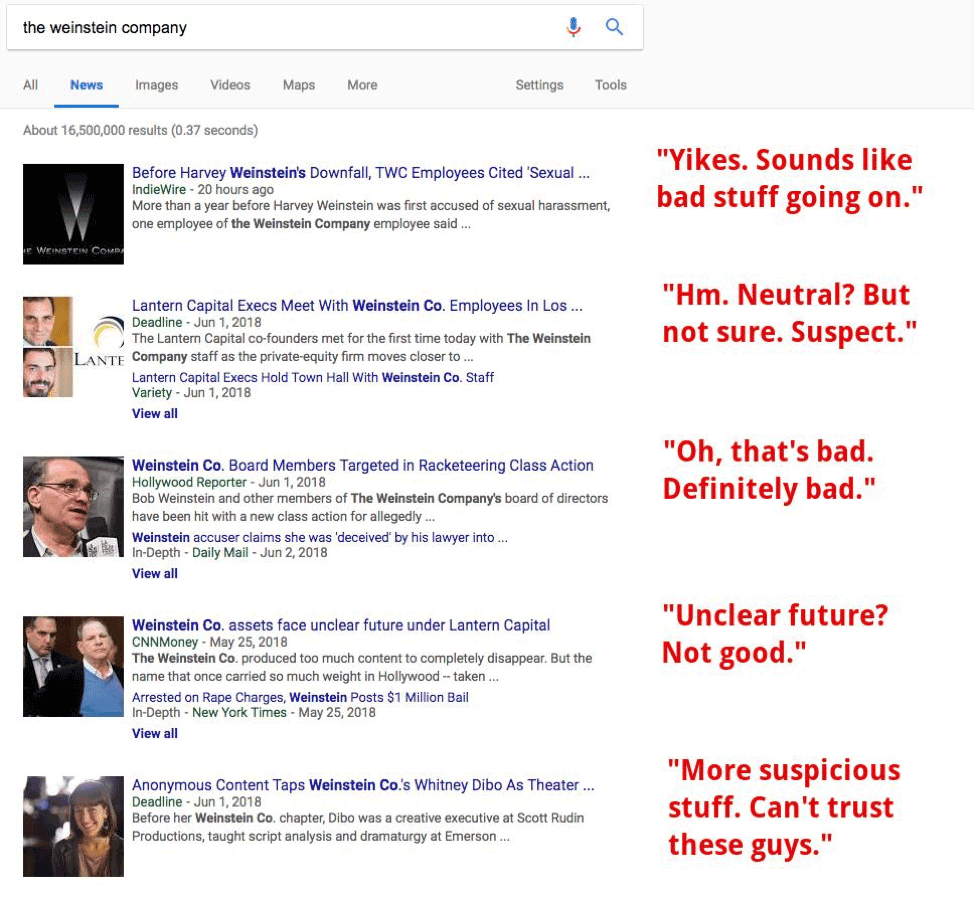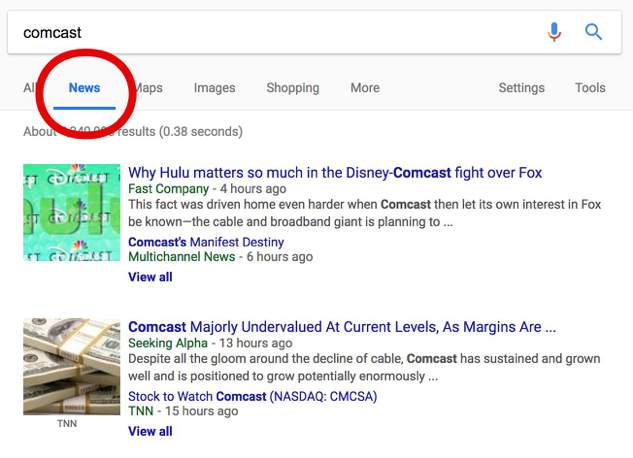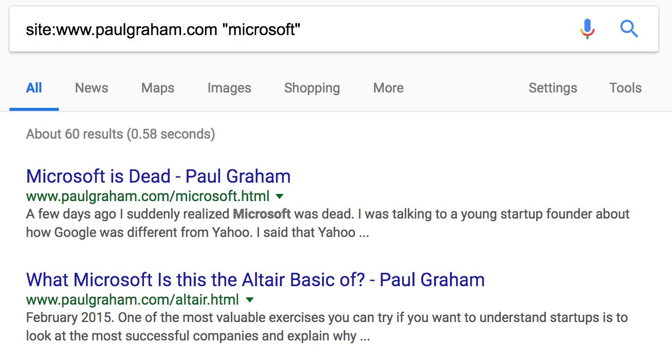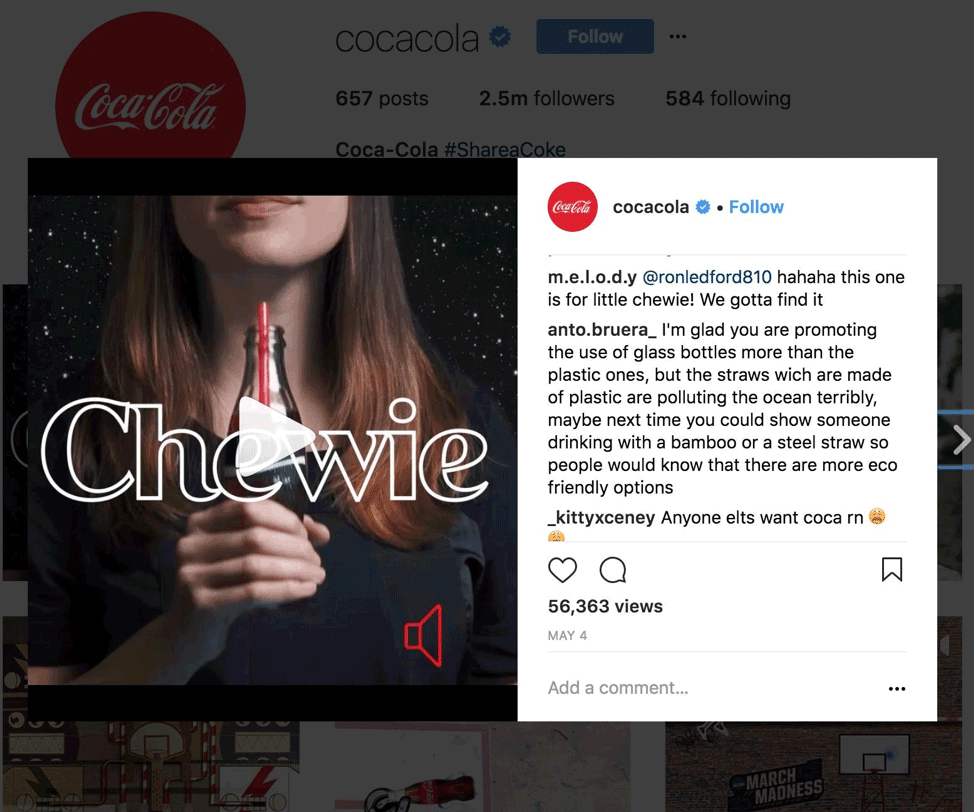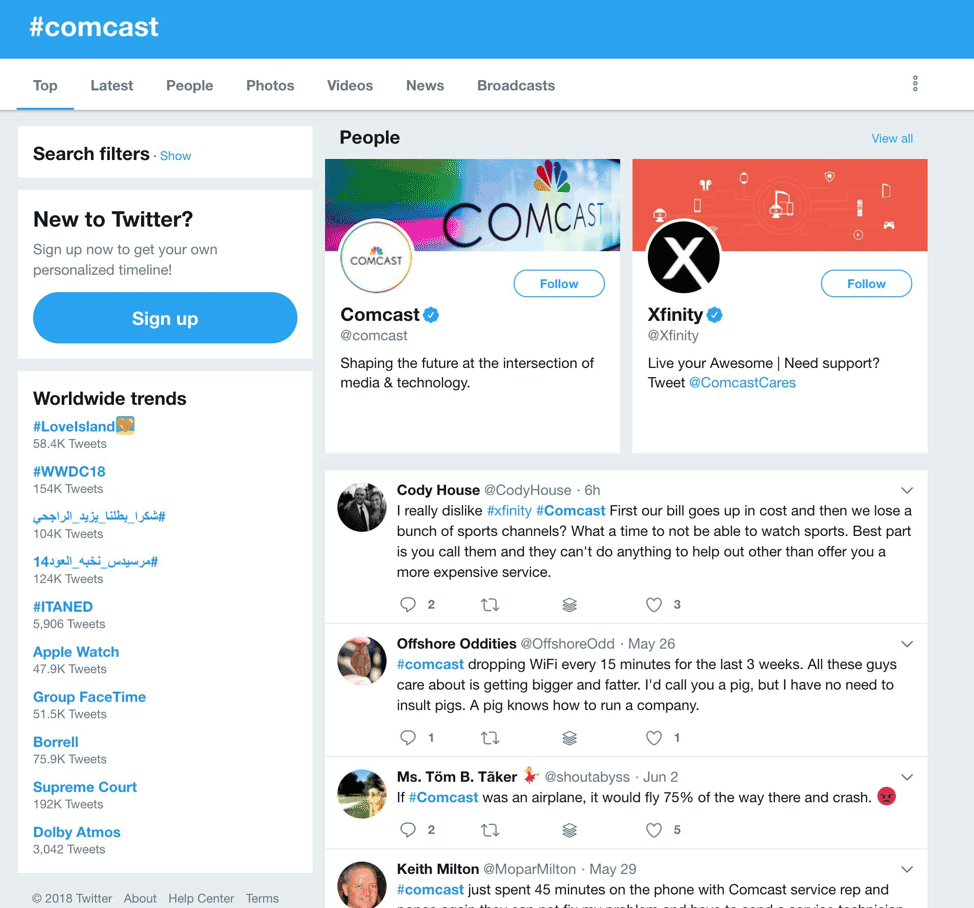Measuring Corporate Sentiment in Todays Online Environment
Corporate sentiment, or business sentiment, is how people feel about your brand. In more technical terms, it’s the level of confidence that shareholders have in a corporation or business—the prevailing mood or attitude about that company’s success (or lack thereof).
Reputation management cares a great deal about corporate sentiment and the practice of sentiment analysis. How people feel about your company defines your business, and understanding this sentiment can help you smooth over attacks on your reputation and promote a positive feeling toward your company.
This article aims to unpack the concept of corporate sentiment—how it’s formed and what factors go into it. Then we’ll teach you how to measure the sentiment surrounding your company.
Why corporate sentiment matters (but is so hard to measure)
Why is corporate sentiment important? Consider this: If corporate sentiment is positive, the stock price will often climb at a healthy rate, the churn rate will drop, customer lifetime value will increase, the candidate pool will brim with top talent, and employees will heartily pursue the company’s objectives and achieve revenue goals.
What if corporate sentiment is sinking? The stock price nosedives. Customers defect to the competition. Employees resign. Would-be candidates flee toward healthier-looking companies.
Corporate sentiment can spell the success or the demise of your company.
Like many features of reputation management, mood, and attitude are hard to quantify, but people do try. The business confidence index (BCI), for example, is an indicator from the Organisation for Economic Co-operation and Development (OECD) that provides a qualitative measure of global economic sentiment.
The graph looks impressive, but corporate sentiment eludes metrics because it has so much to do with individual perceptions and quantity-defying feelings. The nebulous nature of corporate sentiment is a challenge for businesses whose success is dependent on those moods.
Here’s the problem in a nutshell: Corporate sentiment is extremely important, yet there is no single standardized way to quantify it. The closest thing we have to consensus is the Net Promoter Score which asks customers a single question: On a scale of 1-10, how likely are you to recommend this company to a friend or colleague?
The Net Promoter Score is not perfect, but it’s part of the toolbox.
What shapes corporate sentiment?
To understand the genesis of corporate sentiment, look no further than Google.
Yes, Google. Corporate sentiment is shaped by online sentiment. And online sentiment is shaped by Google. Admittedly, this seems like a simplistic way to view the formulation of corporate sentiment; however, it proves quite accurate when you observe the lifecycle of corporate sentiment.
Corporate sentiment begins online.
If you want to find out about something, you Google it, right? Millions of people the world over use Google to look up, well, everything. Google processes 3.5 billion searches per day.
Want to find out how Neiman Marcus is doing? Google it. And if you really want to get some accurate info, click the “News” tab on your Google search results.
This mashup of news stories from disparate sources paints a picture of Neiman Marcus that skews positive. Sure, some shrapnel from the NAFTA detonation may affect the brand, but overall, this looks like a positive mix of information.
Fighting cancer…
….opening a vegan restaurant…
….increasing sales and inventory visibility…
All good stuff, right?
If you’ve never heard of Neiman Marcus, your attitude toward the company is set, probably for the rest of your life. You view the company as a humanitarian, transparent, and egalitarian organization.
Your mind, regarding Neiman Marcus, was a tabula rasa—a clean slate free of preconceived notions. Onto this clean slate was etched a medley of positive sentiments about the company. Now, you think of Neiman Marcus as a darn good company.
It would take a massive upheaval to shift your perception of the company.
Let’s switch it up.
Pretend you’ve never heard of The Weinstein Company. For all you know, it’s a hot dog manufacturer in Philadelphia. (It’s not.)
You Google “the Weinstein Company” and see this:
If this was your very first impression of Weinstein, your confidence in the company would start at a pretty low level.
This is why online sentiment is corporate sentiment. It works like this:
- People seek information on a given subject.
- They search online and have some degree of trust in Google (or at least nowhere else to look for answers).
- What they see becomes their opinion, especially if they don’t have any preexisting attitudes toward the company.
The plot thickens. Google’s search results are not static; the almighty algorithm spews forth the same result for the same search query no matter who’s at the keyboard. Instead, Google personalizes the results based on you: your interests, your location, your device, your search history, and your apparent preferences. Google gives you the information it thinks you want—information that affects how you view the companies and brands you search for. And that means Google has a lot of power when it comes to shaping corporate sentiment.
Corporate sentiment is shaped by individual interests
There’s another factor in the formation of corporate sentiment that we need to be aware of: different people will hold different viewpoints of a company based on their interests.
A stockholder will be looking for different information about a company than the average customer. An employee will be interested in different things too.
Although the overall corporate sentiment may trend positive (or negative), those individual attitudes are being shaped by different pieces of information.
Corporate sentiment is a collection of individual opinions
In summary, corporate sentiment is a collection of opinions from all kinds of people, each with differing interests.
It all begins with an online search. If someone sees negative information regarding your business, their opinion is set. If they see the positive—same thing.
And what if someone sees information that contradicts their original opinion? Usually, they won’t alter their opinion ex post facto. Instead, their mind performs the marvel of confirmation bias—our human tendency to look for and remember information that aligns with what we already believe and to ignore anything contradictory.
Corporate sentiment is complicated, individualized, nebulous, and subject to the vagaries of human cognitive biases. But we can still measure it to a degree. Here’s how.
How to measure corporate sentiment
Measuring corporate sentiment is often referred to as sentiment analysis. Sentiment analysis attempts to understand why people feel the way they do about your company.
There are four components of sentiment analysis:
- Search engine research: analyzing the top search results to get a sense of the mood surrounding your company
- In-depth research: selectively looking at blogs, articles, and reviews to gain a more fleshed-out view of the why and wherefore behind your corporate sentiment
- Social research: performing social listening to find out what the social buzz is around your business
- Competitor research: comparing and contrasting your company with other industry players, gaining insights into what’s expected and what’s unusual when it comes to corporate sentiment in your industry
Let’s take a closer look at each of these four areas.
Search engine research
Search engine research should be done on Google since that is the search engine used by most people. At this level of research, your goal is to understand what kind of results are appearing and the general tenor of those results.
Perform private searches
When you search Google, make sure you are doing so in private mode (called “incognito” in Chrome). That way your search will not be affected by your web cache or other personal information that Google uses to customize search results. Here’s how to put your browser in private mode:
- Chrome: More → New Incognito Window (Command+Shift+N or CTRL+Shift+N)
- Safari: Pages → Private (Command+Shift+N)
- Firefox: Menu → New Private Window (Command+Shift+N or CTRL+Shift+N)
- Internet Explorer: Settings → Safety → In Private Browsing (CTRL+Shift+P)
- Edge: More → New InPrivate Window
Perform location-specific searches for local variation
If your business has an international presence, you may wish to perform searches in another language or as if you were physically in a different country.
For example, let’s say your business is headquartered in Berlin, but you work out of New York. The search results you get while searching in New York will differ from those you would get if searching from Berlin.
You can use www.isearchfrom.com to perform proxy searches from other countries, devices, and languages.
Google your company name and variations of the name
Your search should start at the most basic level: your business name. Beyond that, look for variations of the name, misspellings, typos, etc.
Google your company’s major products or services
Often, corporate sentiment circulates around a business’s products and services, not just the company as a whole. For example, Comcast’s primary product is Xfinity, and many people likely have stronger associations with that name than with Comcast. Be sure to query all your major products and services.
Google the names of company executives
A business’s reputation rises or falls on the actions of its senior leadership. Google the names of the most influential people at your company. See what surfaces at the top of the search results—is it your company website, a Wikipedia article or smoldering news stories and gossip sites?
Google your company name + qualifying words
As you begin to get a picture of the corporate sentiment by performing these searches, you should also be picking up on some words that can help to sharpen your search. Look for keywords that appear regularly in search results about your company. These keywords might be tied to recent events; for example, after Southwest experienced a tragedy on Flight 1380, the accompanying keywords were “tragedy” and “crash.”
If any words recur during your research, add them to your search queries. If not, here are some generic keywords that you can try Googling in conjunction with your business name:
- Review
- Scandal
- News
- Controversy
- Scam
In-depth research
As you perform this search engine research, you will probably encounter some interesting material you’d like to look at more in-depth.
Here are the three main targets of in-depth research:
- 1. News articles. Use Google and filter by the News tab.
This type of search aggregates top-ranked news sources and trending topics to deliver the most relevant results. That’s why this is probably the single most effective method of weighing business sentiment.
- 2. Blogs. Some industry blogs may have written about or mentioned your company. To find all mentions of your company on a particular blog, you can perform a site-specific search.
Here is what you type in to perform a site search: site:www.example.com “your business name”
This is what it looks like in practice:
- 3. Reviews. Thousands of companies rise or fall based on their online reviews. Nearly every business—or its products or services—is reviewed somewhere. Here are review sites to check based on your business category:
- Local businesses: Google, Yelp, Facebook
- Restaurants: Urbanspoon
- Products: Amazon
- Hotels or tourist attractions: TripAdvisor
- Movies: Rotten Tomatoes
- Startups: Crunchbase
- Publicly traded companies: Bloomberg
Your in-depth research aims to take things a step deeper than the search engine results page (SERP) and really listen to what people are saying about your business.
Social research
Social research or social listening can be an unwieldy prospect. Every post on any given social platform contains its own ecosystem of likes, comments, trolls and shares. Your social research does not need to be exhaustive. Again, the goal is to gain a general understanding of the sentiment surrounding your brand.
Look at all your company’s social accounts
To conduct social research, simply take a look at your social accounts and see what people are talking about in your posts.
For example, a quick look at Coca-Cola’s Instagram account shows a user remarking on the company’s use of a plastic straw in a recent commercial.
Search for hashtags related to your company
Many companies will purge their social pages of unsavory or less-than-flattering comments. If your company keeps the comment section clean, you may have to delve into the wild backcountry of hashtags to find not-so-civil material.
If your company has had a promotional hashtag backfire, search this hashtag (popularly called a “bashtag”) to find out why there was such backlash and the theme of the backlash.
Competitor research
By this point in your sentiment analysis project, you should have a relatively accurate understanding of your corporate sentiment. Now you want to add nuance to this understanding by researching one or more of your competitors.
Walk through the same analysis process with a competitor as you did with your own company. When you do so, you may find that some of the public feelings toward your company is actually an industry-wide sentiment. Or you may discover that your competitor’s Wikipedia page ranks very high, whereas your company’s Wikipedia page doesn’t show up until page two, demonstrating an opportunity for you to lift your own Wikipedia results in the search engine results.
You should research a minimum of two competitors to gain the best and widest understanding of competitor research. These should be direct competitors that are roughly the same size and operate in the same geographical area as your company.
The use of tools in corporate sentiment analysis
The best tool for understanding corporate sentiment is the human mind. The following tools can help you conduct sentiment analysis—but it’s up to you to synthesize the information you find.
Conclusion
In reputation management there is no standardized measurement system for the corporate sentiment. But corporate sentiment can be assessed qualitatively. If you are in leadership or PR at your company, measuring your corporate sentiment is a de rigueur marketing activity that you should conduct on a regular basis. Having an awareness of the search results and conversations around your company can help you anticipate and defend against attacks on your reputation.
Corporate Sentiment FAQs
What is corporate sentiment?
Corporate sentiment, or business sentiment, is how people feel about your brand. In more technical terms, it’s the level of confidence that shareholders have in a corporation or business—the prevailing mood or attitude about that company’s success (or lack thereof).
Why is corporate sentiment important?
Corporate sentiment is important because it is directly connected to the success of your business. Businesses with a positive corporate sentiment will enjoy higher stock prices, lower churn rates, higher customer lifetime value, and a large candidate pool.
What influences corporate sentiment?
Corporate sentiment begins online. What people see in Google search results shapes corporate sentiment. What they see becomes their opinion, especially if they don’t have any preexisting attitudes toward the company.
How do you measure corporate sentiment?
Measuring corporate sentiment is often referred to as sentiment analysis. Sentiment analysis attempts to understand why people feel the way they do about your company by researching how people interact with your brand via blogs, articles, reviews, and social media.
About the author
Kent Campbell is the chief strategist for Reputation X, a San Francisco Bay Area-based online reputation management services firm. He has over 15 years of experience with SEO, Wikipedia editing, review management, and online reputation strategy. Kent has helped celebrities, leaders, executives, and marketing professionals improve the way they are seen online. Kent writes about reputation, SEO, Wikipedia, and PR-related topics.
–
Tags: Business Reputation Repair.

